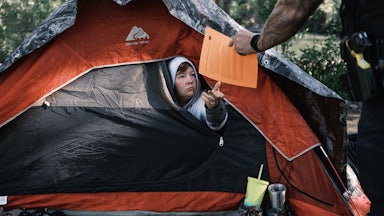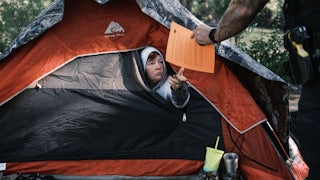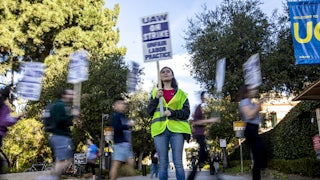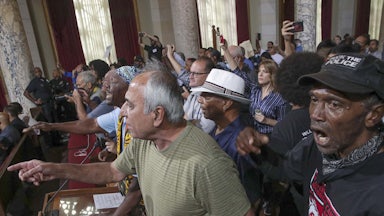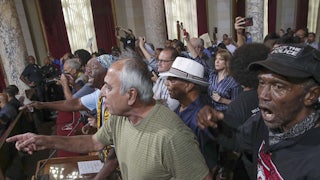A police officer faces the camera in front of a cluster of tents, decrying an encampment’s “deplorable” conditions, particularly the smell. No one, he says, should have to “endure” its presence. A staccato string score crescendos. A swarm of officers readies for a raid. One peels a tent from the ground. In this bluntly propagandistic video, published on the New York Police Department’s social media last May, NYPD Deputy Commissioner Kaz Daughtry congratulates his department on a night’s work clearing “lawless” student protesters from the Columbia University and New York University campuses. Another deputy commissioner, Tarik Sheppard, holds a bike chain. “This is not a tent city,” Sheppard announces. “This is our city.”
Treating survival gear with disgust. Gleefully expelling people from where they sleep. Casting those removed as “them” rather than “us.” The language is as sinister as it is familiar. To celebrate their destruction of students’ Gaza solidarity encampments, NYPD borrowed the ready-made political grammar of homeless encampment sweeps.
The association between student protesters and the homeless cuts both ways. This June, in Grants Pass v. Johnson, the Supreme Court issued a stunning restriction of the civil liberties of unhoused people, ruling that cities could institute total bans on camping and freely fine, jail, and remove unhoused people from public space, even when no alternative shelter was available. To criminalize homeless people for setting up tents is constitutional, Justice Neil M. Gorsuch wrote on behalf of the right-wing supermajority, because camping bans do not single them out: “It makes no difference whether the charged defendant is currently a person experiencing homelessness, a backpacker on vacation, or a student who abandons his dorm room to camp out in protest on the lawn of a municipal building.” In the most important Supreme Court ruling on homelessness in decades, Gorsuch took the opportunity to signal his court’s opinion on student dissent. Unhoused people and protesters, the court suggested, are similarly outsiders in the eyes of the law. The criminalization of one supports and justifies that of the other.
As student protest and unhoused tenant movements regroup to face the fall, it’s worth reflecting on the connections between them, both rhetorical and literal. These connections expose a growing right-wing backlash driven even by liberal institutions and liberal cities. They also point to new lines of solidarity, forged by shared repression and shared stakes in a struggle for human rights here and abroad.
With congressional hearings and a culture war already bearing down on student organizing against the genocide, Columbia students alighted on a tactic that caught: occupying the quad. Institution by institution, students across the country set their sights on divestment from the weapons and logistics industries that sustain Israel’s siege (ties that often fail as financial bets). But it was the persistent physical presence of their encampments that lodged those demands in administrations’ sides and forced them into the mainstream. Though undergraduate tuition makes up only a fraction of university funds, students were able to wield outsize leverage by claiming space and disrupting campus life.
Of course, real estate speculation also pads university endowments. Columbia (New York City’s largest landowner after the Catholic Church) controls 14 million square feet of real estate. The University of California dumped $4.5 billion into the infamous asset management company Blackstone in 2023 alone. Officers of the University of Chicago Police Department (the world’s largest private force after the Catholic Church) recently helped carry out an eviction—of a third-generation Black homeowner. That same week, UChicago offered its vacant student housing to accommodate officers traveling to police protests of the Democratic National Convention. Universities lend technology, techniques, and legitimacy to wars abroad and class war at home—in this case, to the racist criminalization of the poor. To name just one example of the marriage between university research and police mandates, James Q. Wilson, the architect of the discriminatory “broken windows” approach to policing, advanced policy prescriptions from UCLA, where professor Jeffrey Brantingham now hands over his studies to LAPD, laundering racial profiling as “data-driven policing.”
The policing of unhoused people’s encampments was the archetype for the policing of student ones. Many university administrations chose to evict students from dormitories to punish them for their participation. For the legal grounds to sweep the protest sites, police departments turned to camping bans adopted to control homeless people. At Emerson, Boston police committed their brutal sweep of students on the basis of a new city ordinance, the same tool by which they sweep encampments of the unhoused. Nationwide, one of the most common charges students faced on arrest was that of trespassing. Administrations continue to borrow from the anti-homeless arsenal; when school resumes, students will return to fenced lawns and camping bans.
Both unhoused people and student protesters face expanding restrictions on their constitutional rights. Grants Pass reversed almost 20 years of judicial practice, denying unhoused people’s claim to Eighth Amendment protections against cruel and unusual punishment. (Before the decision, municipalities would often just test the amendment’s limits with “time, place, and manner” restrictions; they’d cordon off times of day or particular neighborhoods as exclusion zones, or regulate the amount of space a person or their possessions could take up.) Similarly, students’ First Amendment rights failed to dissuade eviction-eager university administrations; colleges plead private property laws despite persistent self-promotion as incubators of public social change. Students managed to seize on constitutional repression, driving divestment through the wedge of free speech and assembly. But these incursions on the Constitution turn speech and survival into criminal acts and mass evictions and police brutality into business as usual.
As victims of state violence, students are offered vastly more sympathy than unhoused people. Yet the logic of forced removal is the same: Authorities use a perceived threat to health and safety as justification to expel the offending population by force. On some campuses, theoretical harm to Jewish students was levied against those (including Jews) who were protesting actual massacres. On others, the conditions of the camps themselves—where students, like their unhoused neighbors, distributed food and medical supplies—were named a threat. Of the Emerson sweep, Boston Mayor Michelle Wu said, “The growing encampment needed to be removed in order to address the public safety and fire hazards that it presented.” After the sweep, one eyewitness watched city workers power-wash what was presumably a protester’s blood from the sidewalk. For unhoused people, concerns about public health are regularly invoked not as a reason to provide public bathrooms and garbage pick-up, but as the justification for evictions at gunpoint.
Officials, police, and media infantilize both groups, an attitude that aids their criminalization. Like unhoused people, students are routinely described as lacking enough agency to make their own choices. “You’re dealing with children … that aren’t at the mental capacity you are at,” the NYPD chief of patrol announced of students in yet another NYPD propaganda video—this one called “Consequences 101”—which memorialized its sweeps of The New School and NYU. The tactic at once neutralizes the threat students pose and retroactively justifies police intervention.
That police, administrators, and journalists presented students as puppets of agitators from elsewhere illustrates another link: the attempt to construe a community as one made up of or beset by outsiders. The NYPD was at such pains to declare that those arrested at CUNY had descended on the college from elsewhere that it counted only students of City College—one of 25 CUNY campuses—as having gone to the school. Any evidence of organization is suspect. “Why is everybody’s tent the same?” NYC Mayor Eric Adams marveled, parroting a particularly obtuse right-wing take. “We can’t have outside agitators come in and be destructive to our city.” Professors, neighborhood residents (even those subject to rent increases brought on by university land grabs or under the jurisdiction of university police), as well as people of conscience seizing on any possible lever to interrupt mass slaughter must be cordoned off from those with a right to take up space to make political demands.
Recall the useful fantasy that unhoused people travel to set up encampments, while data show the vast majority end up outside in places they have lived long-term. Most are victims of an ordinary emergency—an eviction, a layoff, or a new disability—that illustrates the gaping sieve through which precarious tenants fall into homelessness. But an invented division between insiders and outsiders is productive fodder for nativist resentment. It serves to further erode unhoused people’s access to constitutional protections—in this fantasy, they’re no longer citizens, or even humans. Dehumanization echoes within a global colonial pattern: The dismissal of Palestinian patterns of land use as merely “encampments” provided early leverage for the Zionist project.
Policies that shape the U.S. response to the border and to homelessness have served as key vehicles for U.S. fascism. And since Republican administrations dismantled the invisible bureaucracy that placed migrants indoors, producing a visible crisis of migrants without homes, the categories of migrant and homeless have blurred. Politicians on both sides of the aisle have staked their reputations on stoking outrage at the internationally and internally displaced.
The parallel crackdowns against the most vulnerable members of our society and against dissent represent different facets of the same right-wing retrenchment—carried out by both political parties. (Of note: The NYPD video gives prime placement to removing a tent with a trans flag.) Like many Democrats, California Governor Gavin Newsom has eagerly taken up the right’s task as his own. In the wake of Gorsuch’s Grants Pass decision this July, Newsom sported aviator sunglasses to announce his own executive order demanding homeless sweeps across the state. Weeks later, he wore the shades while personally removing people’s belongings from an underpass.
Vengeful home and business owners have often taken violence into their own hands, particularly out West. Assault by bear spray and power washer, as well as a spate of serial murders, display only the excesses of mass cruelty against the unhoused. Vigilantism takes more subtle forms, too. From 311 calls to new reporting apps, municipalities have codified systems to let complaints drive encampment enforcement, essentially allowing individual constituents to order police sweeps when they please.
It’s no wonder that the peak of vigilante violence was visited upon a student encampment in Los Angeles County. Zionist counterprotesters reproduced tactics of the Israeli Defense Forces in Gaza and of local officials and property owners bent on making outdoor space inhospitable in L.A.; they tormented UCLA students with the sound of babies crying (as do Israeli drones circling Gazans’ tents) and the infamously annoying children’s song “Baby Shark” (the same track used in West Palm Beach’s anti-homeless campaign). As LAPD and campus police stood by in tacit support, the Zionists shot fireworks into the crowd, beat students with boards, and ripped tents from their hands.
“Thank you students,” Tafkeer Hamed Abu Yousef wrote out in green spray paint across his canvas tent in Rafah this April. It was one of many messages of support for student organizing sent by besieged Gazans, forced to shelter in camps as Israel destroys homes, hospitals, schools, and aid infrastructure. Palestinian refugee camps, artifacts of Zionist land grabs and ethnic cleansing, have proved central to Palestinian resistance. (A Palestinian revolution might mean, to use the words of Nasser Abourahme, an assistant professor of Middle Eastern and North African studies, “the transformation of the camps into the means of their own undoing.”)
The global proliferation of tents as symbols of crisis and of resistance is more than coincidence. The settler-colonial paradigm links Palestinians facing the violent excesses of the Jewish ethnostate to Americans ejected into the streets by a housing system originally designed to consolidate white wealth through the theft of Indigenous land.
On American soil, encampments chart a line through a near-century of real estate crises—as means of survival and of dissent. In the Great Depression, mass “Hooverville” encampments of the evicted and unemployed indexed inhabitants’ needs for shelter as much as their demands for jobs and housing. In the 2008 real-estate-driven financial collapse, protesters united under the banner of Occupy Wall Street seized parks and city halls to call for economic transformation. (When the NYPD relocated unhoused people to Zuccotti Park in an attempt to sabotage the protest, organizers refused to turn them away.) Grasping for levers of national and international power, movements make a weapon of getting in the way wherever they are. Inevitably, they meet a backlash honed against those with nowhere to go.
The threat that occupations pose to the dominant order is often revealed in the outsize violence of the typical police response. For now, the continuation of student encampments seems as inevitable as the encampments made by people without homes. Under threat of violent removal, they will collectively occupy space until the need to do so becomes obsolete.

